-

BurnSoothe Dressings
From £3.10 To £6.42Supplied in: Single -

BurnSoothe Burns Kits
From £24.99 To £33.50Supplied in: Single -

BurnSoothe Burn Blotch Gel
£19.61Supplied in: Pack of 25 -

Burnshield Burn Dressings
From £4.47 To £26.18Supplied in: Single -

Burns First Aid Kit in Carry Bag
£30.51Supplied in: Single -

BurnSoothe Burns Kit Refills
From £17.19 To £22.16Supplied in: Single kit -

CoolTherm Burn Dressings
From £7.14 To £18.33Supplied in: Single -

BurnSoothe Gel - Pack of 6
£33.99Supplied in: Pack of 6 -
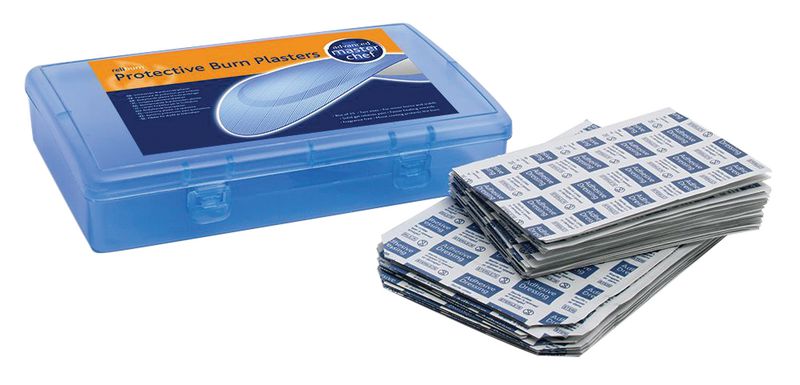
Advanced Hydrogel Burn Plasters
£20.76Supplied in: Pack of 25 -

First Aid For Burns Equipment Bundle
£36.99Supplied in: Single kit -

Modular Burns First Aid Mini Stations
From £48.29 To £48.69Supplied in: Single -

Burnshield Hydrogel
From £0.45 To £4.23Supplied in: Single -

CoolTherm Non-Toxic Large Burn Dressing Single Face Mask
£20.23Supplied in: Single -

BurnSoothe Gel
From £5.02 To £11.02Supplied in: Single -

CoolTherm Non-Toxic Glove Dressing for Hand Burns
£26.04Supplied in: Single -

CoolTherm Burn Gel
£10.36Supplied in: Single
Burns Treatment
Need help?
 How can I prepare for burn injuries in the workplace?
UK Compliant Burns Treatment Supplies – Hot Deals
How can I prepare for burn injuries in the workplace?
UK Compliant Burns Treatment Supplies – Hot Deals
Even without a major fire outbreak, it is possible for employees, visitors and other personnel may require treatment for burns, whilst on your premises.
An often-overlooked element of a first aid kit; equipment such as burn soothes, gels and dressings are essential components in your emergency response arsenal. Ensure you are prepared with our range of specialised burns response products, all dispatched quickly from our UK distribution hub.

Expert Information
Also discover:
First Aid SuppliesEmergency showers/eyewash stationsFirst Aid KitsFirst Aid Room EquipmentFirst aid training equipmentBurns Kits
How To Treat Burns - What You Need To Know
General Guidelines
Even a small accident can cause big problems and painful injuries when it involves burns or scalds. Your office or other workplace doesn’t have to experience a major fire for a worker to need burns treatment - often it can be as simple as an employee will burn a finger on the kettle while making tea or when using the kitchen hob.
At work, at home or at school people are at risk of injury from a broad range of sources. Common causes of painful heat are fires, hot water or steam, chemical compounds, oils, radiation, as well as a range of electrical appliances or lightning. A young child has particularly thinner skin, compared to an adult and as such effects may be further pronounced.
If you’re looking after the needs of employees in a small office, then all you may wish to provide is a supply of soothing gel and dressings, however, if your workplace has numerous staff or is at a high risk of fire, then you should invest in a comprehensive kit, such as our First Aid For Burns Equipment Bundle to support your wider supply of fire safety equipment.
In the case of minor incidents, a specially-formulated gel or dressing, combined with bandaging a burn, will often suffice. We stock a range of such products, including CoolTherm Burn Dressings, which not only protect the burn site and relieve discomfort, but also can actually stop a burn burning and worsening. They come in individual sealed packs and are specially non-adhering so they can be quickly and easily removed.
If you’d prefer something that can be used more than once, BurnSoothe Gel is the ideal product. This gel provides the same amount of comfort and pain relief as a dressing, but in bottle form it can provide relief for a number of people and won’t require to be replaced so regularly. It’s also sterile and non-toxic.
Burn plasters are another product for first aid boxes located in workplaces where most burns and scalds are minimal and can be treated on the spot. These plasters, such as the Advanced Hydrogel Burn Plasters, work as both an adhesive covering and a pain reliever, protecting the burned area from infection and contamination in the same way that a normal plaster does with other small injuries. In this way, they also help provide a speedy recovery period. They are very easy to use and can be applied by the injured person if no medical care is at hand.
For a more comprehensive supply of equipment, it is best to purchase a burns kit. We have several choices available when it comes to burn kits, so whatever you’re looking for we’re very likely to have it in stock. These kits contain everything you need should a worker or child be burned or scalded in the workplace or at school; and in the case of BurnSoothe Burns Kits, you can choose between sizes, with the larger size being compliant with Health and Safety Executive guidelines.
Top 3 Burn Treatments
| Product | Image | Description |
|---|---|---|
| Modular Burn First Aid Kit Mini Station | 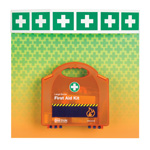 |
British Standard compliant kit Glow-in-the-dark backboard glows for up to 6hrs Combine with our other modular mini stations to create a customised medical response resource |
| Burnshield Burn Dressings | 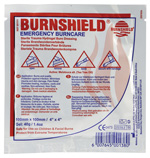 |
Sterile foam pad, coated in a water-based gel to moisturise the affected area Includes tea-tree to cool the skin and minimise tissue damage Designed to be applied directly to the wound, and covered with a conforming bandage |
| CoolTherm Burn Gel | 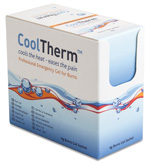 |
Unique gel formulation cools and soothes burn pain Provides a protective barrier against irritants and contaminants, promoting healing Suitable for use when a wound is difficult to dress, or in conjunction with a dressing |
Whether the burn is big or small, having knowledge on how to handle first aid care for a burn injury can improve the health and safety of your staff and visitors. Check out our ‘How to Handle First Aid for Burns in 13 Easy Steps’ page to help your business and protect your employees.
The Six C’s of Burn Care
If a member of your team experiences a burn injury at work, it is vital they receive attention from a dedicated trained individual. Ensuring this important step is not overlooked, makes sure that the damage can be assessed to determine the severity and take the appropriate action to vastly improve the immediate health and welfare of the individual.
Essential care for all burn wounds can be simplified into what is known as the six C’s. Following these guidelines is considered the best way to treat a burn regardless of whether the patient is an adult or child;
- Clothing
- Hot or burned items should be removed immediately. It is important not to force any item adhered to the wound. This is a task for a medical professional in hospital
- Cooling
- This step is pivotal to aiding recovery and reducing severity. It is important to never use ice, ointments or creams to cool the area, to avoid further injury or lead to hypothermia, in the case of larger wounds
- Cleaning
- Like any wound, this step is crucial but may result in significant grievance to the patient. Antibacterial soap and tap water are fine but always ensure the area is thoroughly rinsed
- Chemoprophylaxis
- This is precautionary use of suitable drug products to prevent infection or other disease. At a minimum all burn wounds should receive topical treatment
- Covering
- Proper coverings provide several key benefits including pain relief, protection against contamination and helping to manage drainage. Regardless of burn severity or covering type, always try to avoid circumferential wrapping as this may cause a strangulation effect.
- Comforting
- Burn injuries of any intensity can be traumatic for adults and children alike - as such proper pain management is key. Always avoid aspirin-based solutions as these increase the risk of bleeding. Medication should be administered whenever changing dressings, bandaging a burn or an increase in physical activity, during recovery.
What Not To Do When Treating Burns
No matter the severity of the burn, or where it occurs, there are important actions which must be avoided. In the UK the NHS recommends the following actions are strictly avoided;
Do not attempt to remove any clothing that is stuck to the burnt skin.
Doing so may cause further damage.
Do not use ice, creams or any greasy substances.
Rinse the wound with cool or lukewarm water for 20 minutes.
Do not allow the person’s body temperature to drop below 35°C (95°F).
Add layers of clothing or a blanket to avoid hypothermia.
- Attempting to remove any article of clothing that is adhered to the burnt skin. Doing so could cause further damage
- Applying ice, ice-cooled water or any cream, ointment, oils or otherwise greasy substances, such as butter. Doing so may cause pain or add a layer that needs to be removed in hospital later, which will also cause further distress.
- Allowing the injured individual’s body temperature to drop. Layer blankets or clothing to maintain body temperature, but avoid placing them directly onto the affected skin.
What Happens If You Don’t Treat A Burn
Choosing not to treat a burn poses a risk in itself - mainly because burns and scalding may lead to further issues, depending on the severity and other factors.
The most common outcome is likely contamination of the wound. This is especially likely if a blister bursts, leaving the site exposed. An infected injury can quickly become a medical emergency, requiring treatment from your GP or a doctor in hospital.
To prevent infection, it is vital that all burns, including those with blisters are suitably covered.
At Seton, we stock a full range of suitable products - from BurnSoothe Dressings which provide immediate relief and protection to specialist coverings like the CoolTherm Single Face Mask or CoolTherm Glove Dressing for Hand Burns.
For smaller wounds, our Advanced Hydrogel Burn Plasters provide an effective barrier against bacteria and viruses. These unique plasters contain a pain relieving gel layer, combined with an advanced adhesive designed not to stick to the wound.
FAQ
How do I know if a burn is serious?
All burn injuries are classified as one of three classifications. Traditionally they are referred to as first, second or third degree; however they are more recently called superficial, partial and full thickness respectively.
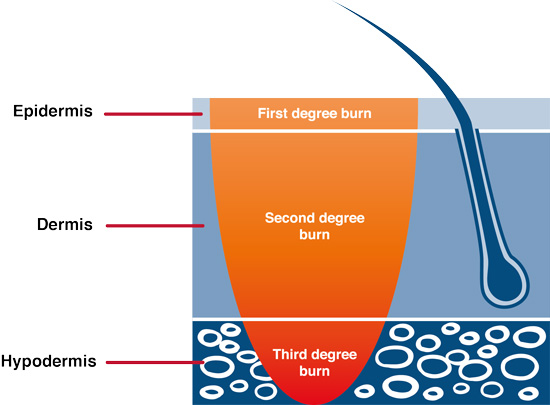
The classification or degree or burn will dictate the intensity of response that may be required. Please see below a general guide on recognising which classification can be treated at the scene and those that may require more serious attention.
| First-Degree (Superficial) |
Second-Degree (Partial Thickness) |
Third Degree (Full Thickness) |
|
|---|---|---|---|
| Skin Layer Affected | Epidermis (uppermost layer) |
Dermis (Mid layer) |
Hypodermis (Lower layer above muscle) |
| Appearance | Red but blanches under pressure | Red but blanches under pressure | White or black in colour, maybe leathery |
| Causes Pain | |||
| Causes Redness | |||
| Causes Swelling | |||
| Causes Blistering | |||
| Causes Numbness |
Whilst superficial cases can be treated at home, it is recommended that any symptoms of partial or full thickness injuries are seen by a doctor. For the most severe cases, this should be handled as an emergency.
What creams are good for burns?
In providing first aid to a burn injury, you should never use creams, ointments or similarly greasy substances - like butter. There are many home remedies for burns and scalds that recommend such items, however it is especially the case with more severe burn wounds, doing so may cause further damage and pain; when it needs to be removed in hospital later.
While there are various moisturising, even antibiotic substances that can be applied to less severe wounds during the healing process, we strongly recommend to keep the wound covered with a hydrogel-based covering - such as Advanced Hydrogel Burn Plasters and Burnshield Hydrogel. Using both of these products together will provide some pain relief and assist recovery of the wound, whilst helping to keep it protected against contamination.
How do I know if a burn is healing?
Depending on the severity, the person may experience a combination of symptoms during the recovery process. These might include blisters, torn skin or ulcerations as well as itching during the recovery process.
| Blister | Itching | Torn Skin | Colour Changes | Purple Swelling | Increased Thickness | Discharge | Fever | |
|---|---|---|---|---|---|---|---|---|
| Normal | ||||||||
| Infection |
However if there are any signs of infection, this will require urgent professional medical attention to ensure proper recovery. Common signs to look out for include;
How long does it take for a burn to heal completely?
The NHS advises that minor burn injuries - those classified as first-degree or superficial - normally heal after treatment in around a week to 14 days. This timescale serves as a good guide for both adults and children alike.
Minor burns affecting the outer layer of skin and some of the underlying layer of tissue (superficial dermal burns) normally heal in around 14 days, leaving minimal scarring.
It is important to remember that more severely burnt skin - such as those injuries which may require a skin graft - will remain particularly sensitive during the first year, following the injury.
Should you cover a burn or let it breathe?
NHS guidance advises that any burn wound should be kept covered, as much as possible, to encourage recovery and protect against complications; such as infection. This is true whether you are treating burns that blister as well as those that don’t.
It is especially important to keep any areas of burnt skin covered if the area is expected to be exposed to direct sunlight.
During the first few years after a burn, you should try to avoid exposing the damaged skin to direct sunlight as this may cause it to blister.
It's important to keep the area covered with cotton clothing. If the burn or scald is on your face, wear a peaked cap or wide-brimmed hat when you're out in the sun.
Do I really need burns treatment supplies in my workplace?
Yes. Even workers in small offices and self-employed workers working from home can be at risk of small burns and scalds, especially if you have an on-site kitchen. Just including a burn gel or a pack of burn dressings could help in the event of an accident however large or small the office.
Which burns treatment is best for my workplace?
This will depend on the size and nature of the workplace, but we suggest looking at the buying guide above to determine which product would work best for you and your workers. Largely, however, if you work in an office or environment of a larger size, then investing in a burns kit would be a good idea.
| BurnSoothe Burns Kits | Image | Contents | |
|---|---|---|---|
| Medium | 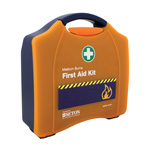 |
Burnsoothe Burn Blot Sachet 3.5g | 8 |
| Burnsoothe Burn Relief Dressing 10cm x 10cm | 3 | ||
| Burnsoothe Burn Relief Dressing 2.5cm x 5cm | 4 | ||
| Eye Wash Single Pod of 20ml | 2 | ||
| Foil Blanket Adult Size - 130cm x 210cm | 1 | ||
| Reliance First Aid Guidance Leaflet | 1 | ||
| Reliform Conforming Bandage 5cm x 4m | 1 | ||
| Reliform Conforming Bandage 7.5cm x 4m | 1 | ||
| Religlove Vinyl Powder-Free Medium Single Pair | 1 | ||
| Relitape Microporous Tape 1.25cm x 1m | 1 | ||
| Universal Shears Small 6” | 1 | ||
| Large | 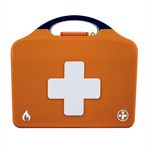 |
Guidance Leaflet | 1 |
| Gloves (Pair) | 1 | ||
| Burn Gel Sachet 3.5g | 8 | ||
| Burn Relief Dressing 5cm x 15cm | 1 | ||
| Burn Relief Dressing 10cm x 10cm | 2 | ||
| Burn Relief Dressing 20cm x 20cm | 1 | ||
| Burn Relief Gel Bottle 125ml | 1 | ||
| Conforming Bandage 10cm x 4m | 1 | ||
| Universal Shears | 1 | ||
| Tamperseal Label | 1 | ||
How often should I replace the items in my burns kit?
You should replace whatever you use as soon as possible and keep an eye on the use by dates of any sterile products kept in the kit. We have a range of BurnSoothe Burns Kit Refills to choose from should you wish to replace anything, without needing to repurchase an entire kit.


